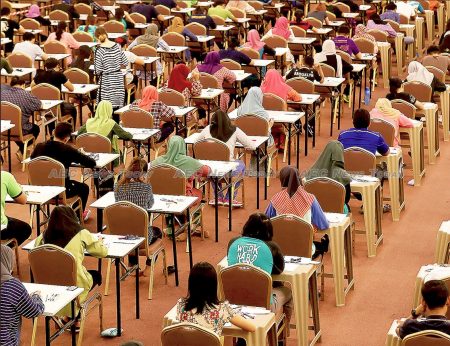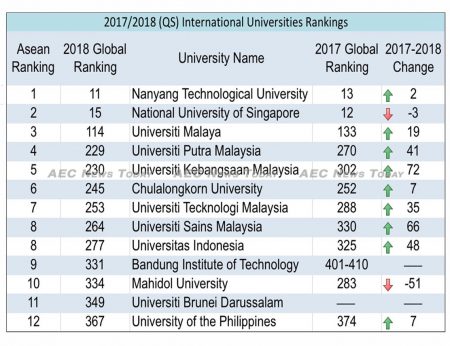The National University of Singapore (NUS) has long ruled as the undisputed pinnacle of Asean higher education. In almost all international university rankings, with the exception of those that have restricted categories, Nanyang Technological University (NTU) has played second fiddle.
All that changed during the week with the release of the 2018 World University Rankings by Quaoquarelli Symonds (QS), a British company specialising in education, which saw NUS dethroned by its younger higher education rival.
Ranked number 12 in the 2017 QS World University Rankings, and 24th in the Times 2016-2017 World University Rankings released in March this year, the highly regarded NUS fell three places in the 2018 QS World University Rankings to finish 15th in the world.
At the same time, moving up two places from its 13th position in the snakes and ladders like world of international university rankings was NTU, claiming the 11th spot globally and garnering a five-star rating in eight categories in the process.
Ranked first in the ‘Top 50 under 50 and next 50 under 50‘ index, fourth in the 2017 Asian University Rankings, and 54th in the 2016-2017 World University Rankings, NTU saw its score in four of QS’s six metrics used for ranking improve over the previous 12 months.
Also moving up the list in Singapore was the Singapore Management University (SMU) which went from 431-440 in the 2017 QS World University Rankings to 441-450 in the latest list.
Acknowledging this year’s QS World University Rankings, Professor Bertil Andersson, President of NTU said: “We know competition is extremely stiff in the upper echelon of the world’s best universities. To climb up to the 11th spot (this year), just one place shy of the top 10, is remarkable progress. Singaporeans should be very proud that this small nation has two world-class universities.”
Malaysia: Asean’s Emerging Higher Education Hub

While the quality of Singapore’s higher education sector has long been the envy of many, for the sheer number of ranked entries one needs to look at neighbouring Malaysia.
Rapidly emerging as a hub of Asean higher education, Malaysia is home to Asean’s third, fourth, fifth, seventh, and eighth highest ranked international universities.
Leading Malaysia’s charge up the international university rankings is Universiti Malaya (UM), which moved up 19 places over 2017 to rank 114th globally in the 2018 list and claim with it the title of the third highest ranked Asean higher education institutes.
At 229 in the 2018 QS World University Rankings, Asean’s fourth highest ranked internal university is Universiti Putra Malaysia (UPM), which climbed 41 places from 270th in 2017, while Universiti Kebangsaan Malaysia (UKM) went from 302nd in 2017 to 230th in 2018, a rise of 72.
Universiti Tecknologi Malaysia (UTM) moved up 35 places in the 2018 QS World University Rankings to 253rd globally, while Universiti Sains Malaysia (USM) jumped 66 places from 2017 to be ranked 264 in the world in the 2018 list.
Other Malaysian higher education institutions to make the 2018 QS World University Rankings Universiti Teknologi Petronas (Petronas) ranked 601-650, International Islamic University Malaysia (IIUM) and Universiti Utara Malaysia (UUM) ranked 701-750, and Universiti Teknologi MARA (UiTM), which was ranked 751-800.
Thailand Higher Education: Like Lipstick on a Pig

In Thailand, home to some of the regions most established (and expensive) higher education institutions the 2018 QS International University Ranking presents far from cheery reading.
Thailand’s number one university, the 100-year-old Chulalongkorn University (CU), leads Thailand universities into this years list with a global ranking of 245. An increase of seven places above its ranking in the 2017 QS International University Ranking, ‘Chula’ also claims the title of Asean’s sixth highest ranked university.
Taking Thailand’s second, and only other ranked spot in the 2018 QS International University Rankings, is Mahidol University (MU), Thailand’s fourth oldest public university, which came in at 334th globally; a drop of 51 places over its ranking in the 2017 QS International University Ranking.
Other Thailand universities to make the 2018 QS International University Ranking were Chiang Mai University and Thammasat University, which each ranked 601-650, and Kasetsart University, Khon Kaen University, King Mongkut’s University of Technology Thonburi, and Prince of Songkla University all ranked 701+.
While CU is justifiably proud of its increased ranking, when it comes to Thailand’s attempts to brand itself as an education hub, it is much like putting lipstick on a pig. Nor does it auger well for the junta’s recently unveiled Thailand 4.0 strategy, which will need a well educated and skilled labour force if it is to achieve its aims.
Indonesia’s Higher Education Tragedy
In Indonesia Universitas Indonesia (UI) moved up 48 places to rank 277 globally and take the title of Asean’s eighth highest ranked university, after holding the 325th place the year prior. Bandung Institute of Technology (ITB), the only other Indonesia higher education institution to gain a rank in the 2018 QS World University Ranking, moved up from 401-410 in 2017 to 331 globally in the 2018 list.
Further down the 2018 QS International University Rankings for Indonesia were: Airlangga University (AU) (701-750), Bogor Agricultural University (BAU) (751-800), and Diponegoro University (DP), Institute of Technology Sepuluh Nopember (ITSN), Universitas Muhammadiyah Surakarta (UMS), and University of Brawijaya (UB), which were all ranked between 801 and 1,000 globally.
Philippines Higher Education: Dismal
The state of higher education in the Philippines is even more dismal than Thailand. Although the University of the Philippines (UP) improved seven places in the 2018 QS International University Rankings over the year prior to be ranked 367th globally, the good news ends there.
Ateneo de Manila University (AMU), the University of Santo Tomas (UST), and University of Santo Tomas, the only other Philippines higher education institutions to make the list, all ranked a far from impressive 551-600, 701-750, and 801-1,000 respectively.
Entering the 2018 QS International University Rankings for the first time is the 32-year-old Universiti Brunei Darussalam (UBD). Home to 495 faculty, more than 50 per cent of who are international, and some 2,933 students, UBD scored an impressive 349 in the 2018 QS International University Rankings.

Compiled for the 14th year, the 2018 International University Rankings scores 959 universities globally using six metrics – academic reputation, employer reputation, faculty to student ratio, citation per faculty, the international faculty ratio, and the international student ratio – to measure performance.
More than 75,000 academics and 40,000 employers are said to have contributed to this year’s report, with 12.3 million papers and 71.5 million citations analysed.
According to the authors the purpose of the research is to help aspiring students get a definitive picture of the strengths and educational backgrounds of different universities – covering everything from research and employment outcomes, to social responsibility and inclusiveness.
For foreign investors it paints a useful picture of the level of commitment individual countries have to higher education and the development of smarter labour forces able to handle the challenges of the 21st century.
While many Asean leaders are publicly embracing Industry 4.0, the 2018 QS World University Rankings show that few are investing the resources necessary in higher education to make the leap.
Related:
- NTU rises to 11th in global university ranking, surpassing NUS (Yahoo Singapore News)
- Chulalongkorn U ranked 245th in world’s best universities for 2018 (Thai PBS)
- University of Indonesia Ranks 277th in the World: Quacquarelli Symonds (Jakarta Globe)
Stella-maris Ewudolu
Between November 2010 and February 2012 she was a staff writer at Daylight Online, Nigeria writing on health, fashion, and relationships. From 2010 – 2017 she worked as a freelance screen writer for ‘Nollywood’, Nigeria.
She joined AEC News Today in December 2016.
Latest posts by Stella-maris Ewudolu (see all)
- Zoonotic crossover fear sees Vietnam ban (almost) all wildlife trade (video) – July 26, 2020
- Job & revenue losses: COVID-19 to hurt Asean airlines the most – July 24, 2020
- Philippines morning news for July 24 – July 24, 2020
- Philippines morning news for July 23 – July 23, 2020


